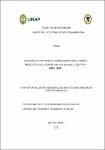| dc.contributor.advisor | Vásquez Matute, Armando | |
| dc.contributor.author | Pezo Gálvez, Héctor Gilberto | |
| dc.date.accessioned | 2021-09-21T12:45:40Z | |
| dc.date.available | 2021-09-21T12:45:40Z | |
| dc.date.issued | 2021 | |
| dc.identifier.uri | https://hdl.handle.net/20.500.12737/7481 | |
| dc.description.abstract | El presente trabajo de investigación tuvo como problema planteado: ¿En qué
medida la ecología cuantitativa se relaciona con la cadena productiva del
aguaje (Maurita flexuosa L.) Iquitos – Perú, 2019?, El Objetivo general fue
determinar la relación entre la ecología cuantitativa y la cadena productiva del
aguaje, los objetivos específicos fueron determinar la relación entre la
frecuencia relativa y la cadena productiva del aguaje, determinar la relación
entre el área basal y la cadena productiva del aguaje, determinar la relación
entre la densidad relativa y la cadena productiva del aguaje, determinar la
relación entre la dominancia relativa y la cadena productiva del aguaje. En la
metodología para ecología cuantitativa se empleó los cuadrantes y transeptos
y para la cadena productiva se utilizó el método de las encuestas, el
instrumento fue el cuestionario, las encuestas se realizó en una población
infinita, mediante un muestreo por conveniencia, no probabilístico, el diseño
de investigación corresponde al tipo no experimental, descriptivo y
correlacional. Los resultados que se encontraron fueron: 29 especies dentro
del área de estudio que va desde especies maderables, medicinales y
productivos, dentro de las cuales el aguaje es la especie dominante con el
78.8 % de dominancia relativa, finalmente podemos concluir, afirmando
categóricamente que la ecología cuantitativa de un aguajal tiene relación con
su cadena productiva, afirmación válida hasta con 95% de confianza. | es_PE |
| dc.description.abstract | The present research work had as a problem posed: To what extent is
quantitative ecology related to the productive chain of aguaje (Maurita flexuosa
L.) Iquitos - Peru, 2019? The general objective was to determine the
relationship between quantitative ecology and the productive chain of the
aguaje, the specific objectives were to determine the relationship between the
relative frequency and the productive chain of the aguaje, determine the
relationship between the basal area and the productive chain of the aguaje,
determine the relationship between the relative density and the productive
chain of the aguaje, determine the relationship between relative dominance
and the aguaje production chain. In the methodology for quantitative ecology,
the quadrants and transepts were used and for the production chain the survey
method was used, the instrument was the questionnaire, the surveys were
carried out in an infinite population, through a non-probabilistic convenience
sampling research design corresponds to the non-experimental, descriptive
and correlational type. The results that were found were: 29 species within the
study area that ranges from timber, medicinal and productive species, within
which aguaje is the dominant species with 78.8% relative dominance, we can
finally conclude, stating categorically that the satín quantitative ecology of an
aguajal is related to its production chain, a statement valid with up to 95%
confidence. | es_PE |
| dc.format | application/pdf | es_PE |
| dc.language.iso | spa | es_PE |
| dc.publisher | Universidad Nacional de la Amazonía Peruana | es_PE |
| dc.rights | info:eu-repo/semantics/openAccess | es_PE |
| dc.rights.uri | https://creativecommons.org/licenses/by/4.0/ | es_PE |
| dc.subject | Ecología | es_PE |
| dc.subject | Cadena alimentaria | es_PE |
| dc.subject | Producción | es_PE |
| dc.subject | Aguaje | es_PE |
| dc.subject | Mauritia flexuosa | es_PE |
| dc.title | Ecología cuantitativa y su relación con la cadena productiva del aguaje, (Mauritia flexuosa L.) Iquitos – Perú, 2019 | es_PE |
| dc.type | info:eu-repo/semantics/masterThesis | es_PE |
| thesis.degree.discipline | Maestría Ciencias Gestión Ambiental | es_PE |
| thesis.degree.grantor | Universidad Nacional de la Amazonía Peruana. Escuela de Posgrado | es_PE |
| thesis.degree.name | Maestro(a) en Ciencias en Gestión Ambiental | es_PE |
| dc.subject.ocde | http://purl.org/pe-repo/ocde/ford#1.06.13 | es_PE |
| renati.author.dni | 43587990 | |
| renati.advisor.orcid | https://orcid.org/0000-0002-6726-8103 | es_PE |
| renati.advisor.dni | 07254055 | |
| renati.type | http://purl.org/pe-repo/renati/type#tesis | es_PE |
| renati.discipline | 521227 | es_PE |
| renati.level | https://purl.org/pe-repo/renati/level#maestro | es_PE |
| renati.juror | Ramírez Chung, José Francisco | |
| renati.juror | Tello Fernández, Ronald | |
| renati.juror | Delgado Vásquez, Octavio | |
| dc.publisher.country | PE | es_PE |


